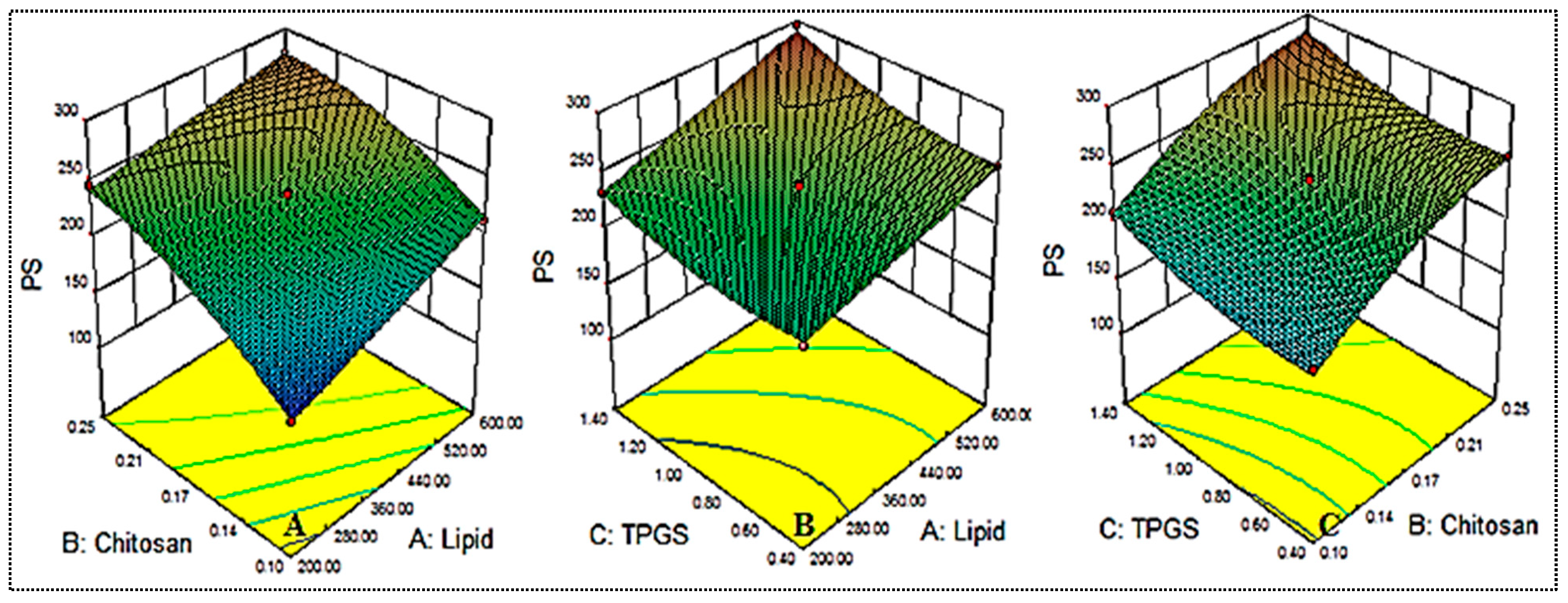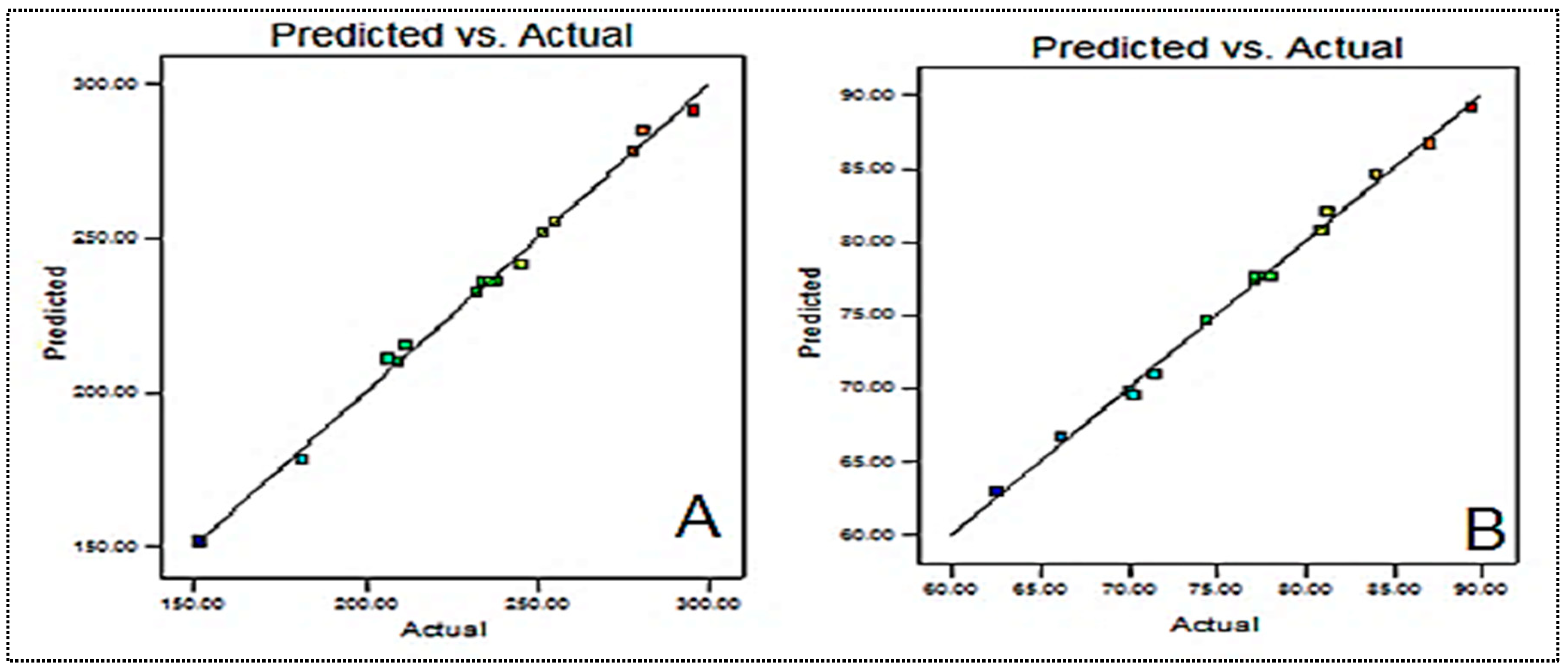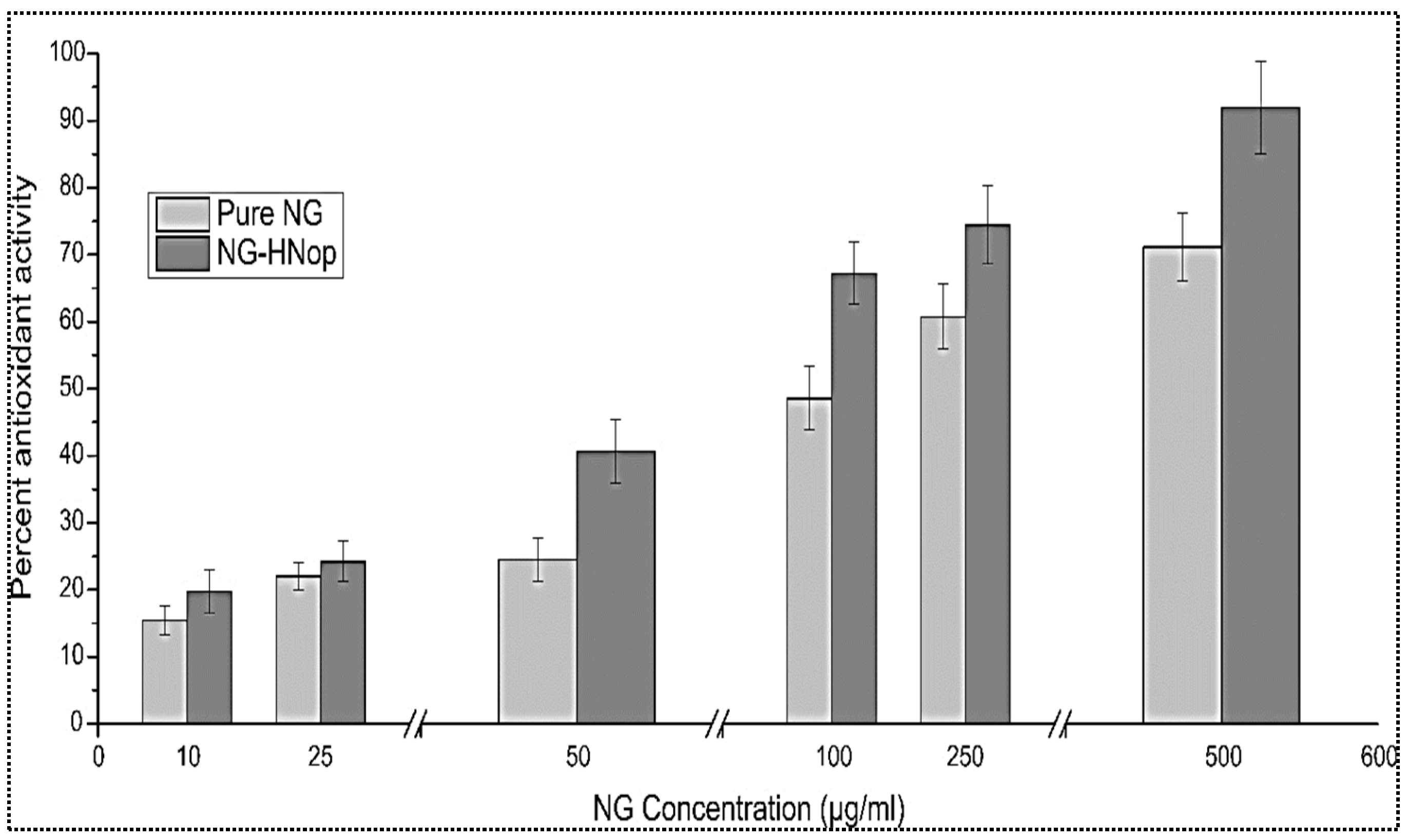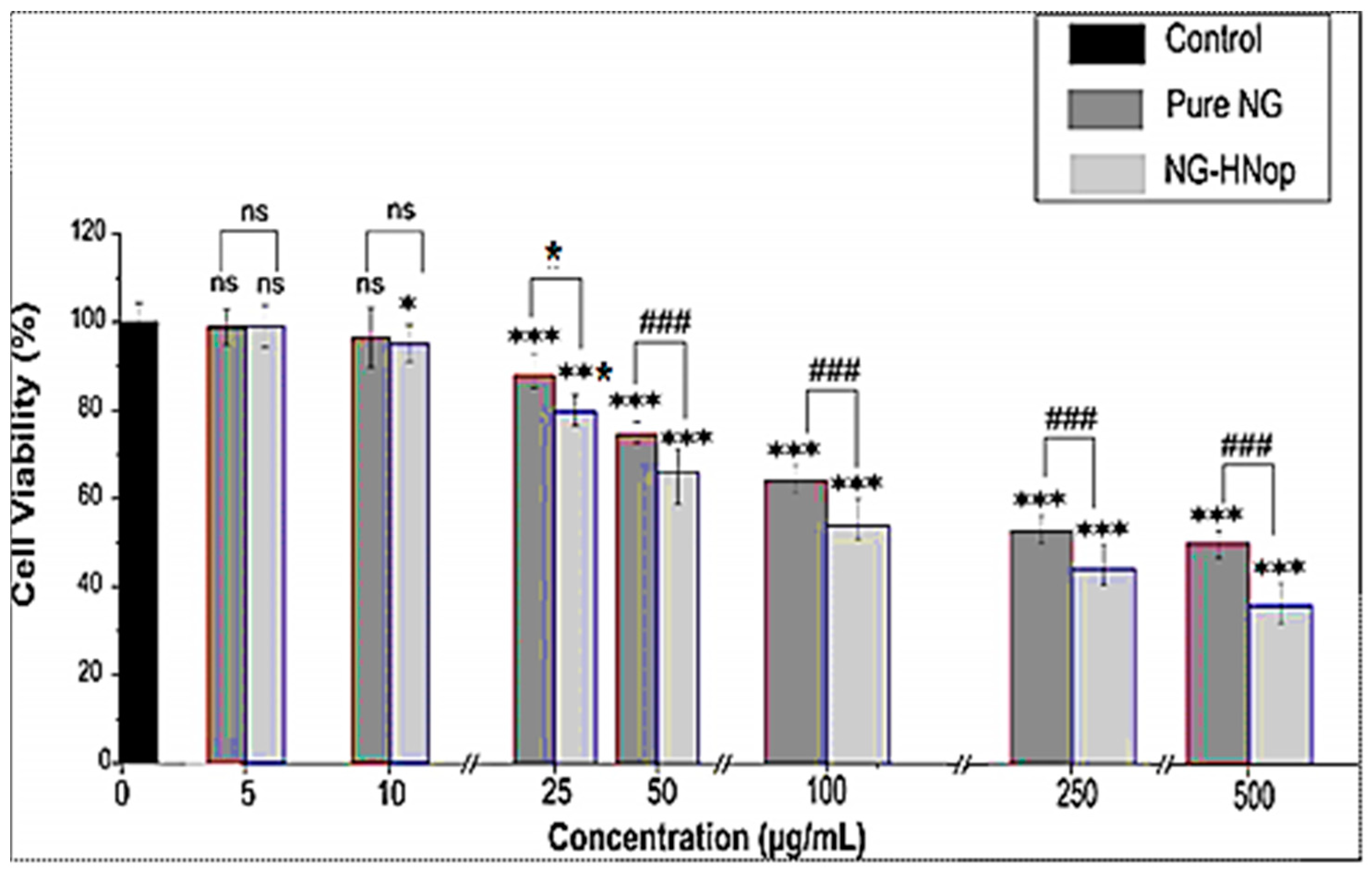Preparation and Optimization of Naringin Oral Nanocarrier: In Vitro Characterization and Antibacterial Activity
Abstract
:1. Introduction
2. Materials
3. Experimental Section
3.1. Box–Behnken Design
3.2. Preparation of Nanoparticles
3.3. Characterization
Particle Characterization
3.4. Entrapment Efficiency (EE)
3.5. In Vitro Release Study
3.6. Ex Vivo Permeation Study
3.7. Antioxidant Study
3.8. Antibacterial Activity
3.9. Cell Viability Study
4. Statistical Analysis
5. Results and Discussion
5.1. Optimization
5.2. Influence of Independent Factors on Particle size (Y1)
5.3. Influence of Independent Constraints on Entrapment Efficiency (Y2)
5.4. Selection of Optimized Composition
5.5. In Vitro Release Study
5.6. In Vitro Permeation Study
5.7. Antioxidant Activity
5.8. Antibacterial Activity
5.9. Cell Viability Study
6. Conclusions
Author Contributions
Funding
Institutional Review Board Statement
Informed Consent Statement
Data Availability Statement
Acknowledgments
Conflicts of Interest
References
- Pouton, C.W. Formulation of poorly water-soluble drugs for oral administration: Physicochemical and physiological issues and the lipid formulation classification system. Eur. J. Pharm. Sci. 2006, 29, 278–287. [Google Scholar] [CrossRef] [PubMed]
- Alkhalidy, H.; Wang, Y.; Liu, D. Dietary Flavonoids in the Prevention of T2D: An Overview. Nutrients 2018, 10, 438. [Google Scholar] [CrossRef] [PubMed] [Green Version]
- Panche, A.N.; Diwan, A.D.; Chandra, S.R. Flavonoids: An overview. J. Nutr. Sci. 2016, 5, e47. [Google Scholar] [CrossRef] [PubMed] [Green Version]
- Céliz, G.; Daz, M.; Audisio, M.C. Antibacterial activity of naringin derivatives against pathogenic strains. J. Appl. Microbiol. 2011, 111, 731–738. [Google Scholar] [CrossRef] [PubMed] [Green Version]
- Singh, B.; Singh, J.P.; Kaur, A.; Singh, N. Phenolic composition, antioxidant potential and health benefits of citrus peel. Food Res. Int. 2020, 132, 109114. [Google Scholar] [CrossRef]
- Aihaiti, Y.; Song Cai, Y.; Tuerhong, X.; Ni Yang, Y.; Ma, Y.; Zheng, H.S.; Xu, K.; Xu, P. Therapeutic Effects of Naringin in Rheumatoid Arthritis: Network Pharmacology and Experimental Validation. Front. Pharmacol. 2021, 12, 672054. [Google Scholar] [CrossRef]
- Mohamed, E.A.; Abu Hashim, I.I.; Yusif, R.M.; Shaaban, A.A.A.; El-Sheakh, A.R.; Hamed, M.F.; Badria, F.A.E. Polymeric micelles for potentiated antiulcer and anticancer activities of naringin. Int. J. Nanomed. 2018, 13, 1009–1027. [Google Scholar] [CrossRef]
- Den Hartogh, D.J.; Tsiani, E. Antidiabetic Properties of Naringenin: A Citrus Fruit Polyphenol. Biomolecules 2019, 9, 99. [Google Scholar] [CrossRef] [Green Version]
- Hsiu, S.L.; Huang, T.Y.; Hou, Y.C.; Chin, D.H.; Chao, P.D. Comparison of metabolic pharmacokinetics of naringin and naringenin in rabbits. Life Sci. 2002, 70, 1481–1489. [Google Scholar] [CrossRef]
- Rao, K.; Imran, M.; Jabri, T.; Ali, I.; Perveen, S.; Ahmed, S.; Shah, M.R. Gum tragacanth stabilized green gold nanoparticles as cargos for Naringin loading: A morphological investigation through AFM. Carbohydr. Polym. 2017, 174, 243–252. [Google Scholar] [CrossRef]
- Hussain, K.; Ali, I.; Ullah, S.; Imran, M.; Parveen, S.; Kanwal, T.; Shah, S.A.; Saifullah, S.; Shah, M.R. Enhanced Antibacterial Potential of Naringin Loaded β Cyclodextrin Nanoparticles. J. Clust. Sci. 2022, 33, 339–348. [Google Scholar] [CrossRef]
- Singh, A.; Neupane, Y.R.; Panda, B.P.; Kohli, K. Lipid Based nanoformulation of lycopene improves oral delivery: Formulation optimization, ex vivo assessment and its efficacy against breast cancer. J. Microencapsul. 2017, 34, 416–429. [Google Scholar] [CrossRef] [PubMed]
- Baek, J.S.; Cho, C.W. Surface modification of solid lipid nanoparticles for oral delivery of curcumin: Improvement of bioavailability through enhanced cellular uptake, and lymphatic uptake. Eur. J. Pharm. Biopharm. 2017, 117, 132–134. [Google Scholar] [CrossRef] [PubMed]
- Wang, H.; He, Y.; Hou, Y.; Geng, Y.; Wu, X. Novel self-nanomicellizing formulation based on Rebaudioside A: A potential nanoplatform for oral delivery of naringenin. Mater. Sci. Eng. C Mater. Biol. Appl. 2020, 112, 110926. [Google Scholar] [CrossRef]
- Duong, T.T.; Yen, T.T.H.; Nguyen, L.T.; Nguyen, T.D.; Nguyen, T.Q.; Nghiem, T.H.; Pham, H.T.; Raal, A.; Heinämäki, J.; Pham, T.M. Berberine-loaded liposomes for oral delivery: Preparation, physicochemical characterization and in vivo evaluation in an endogenous hyperlipidemic animal model. Int. J. Pharm. 2022, 616, 121525. [Google Scholar] [CrossRef]
- Feng, S.S.; Mei, L.; Anitha, P.; Gan, C.W.; Zhou, W. Poly(lactide)-vitamin E derivative/montmorillonite nanoparticle formulations for the oral delivery of Docetaxel. Biomaterials 2009, 30, 3297–3306. [Google Scholar] [CrossRef]
- Liang, J.; Liu, Y.; Liu, J.; Li, Z.; Fan, Q.; Jiang, Z.; Yan, F.; Wang, Z.; Huang, P.; Feng, N. Chitosan-functionalized lipid-polymer hybrid nanoparticles for oral delivery of silymarin and enhanced lipid-lowering effect in NAFLD. J. Nanobiotechnol. 2018, 16, 64. [Google Scholar] [CrossRef]
- Zafar, A.; Alruwaili, N.K.; Imam, S.S.; Alsaidan, O.A.; Ahmed, M.M.; Yasir, M.; Warsi, M.H.; Alquraini, A.; Ghoneim, M.M.; Alshehri, S. Development and Optimization of Hybrid Polymeric Nanoparticles of Apigenin: Physicochemical Characterization, Antioxidant Activity and Cytotoxicity Evaluation. Sensors 2022, 22, 1364. [Google Scholar] [CrossRef]
- Ozcan, I.; Azizoglu, E.; Senyigit, T.; Ozyazıcı, M.; Ozer, O. Enhanced dermal delivery of diflucortolone valerate using lecithin/chitosan nanoparticles: In-vitro and in-vivo evaluations. Int. J. Nanomed. 2013, 8, 461–475. [Google Scholar] [CrossRef] [Green Version]
- Senyigit, T.; Sonvico, F.; Barbieri, S.; Ozer, O.; Santi, P.; Colombo, P. Lecithin/chitosan NPs of clobetasol-17-propionate capable of accumulation in pigskin. J. Control. Release 2010, 142, 368–373. [Google Scholar] [CrossRef]
- Perez-Ruiz, A.G.; Ganemb, A.; Olivares-Corichi, I.M.; García-Sánchez, J.R. Lecithin–chitosan–TPGS nanoparticles as nanocarriers of (−)-epicatechin enhanced its anticancer activity in breast cancer cells. RSC Adv. 2018, 8, 34773–34782. [Google Scholar] [CrossRef] [PubMed] [Green Version]
- Fereig, S.A.; El-Zaafarany, G.M.; Arafa, M.G.; Abdel-Mottaleb, M.M.A. Self-assembled tacrolimus-loaded lecithin-chitosan hybrid nanoparticles for in vivo management of psoriasis. Int. J. Pharm. 2021, 608, 121114. [Google Scholar] [CrossRef] [PubMed]
- Mutlu-Agardan, N.B.; Han, S. In vitro and in vivo evaluations on nanoparticle and phospholipid hybrid nanoparticles with absorption enhancers for oral insulin delivery. Pharm. Dev. Technol. 2021, 26, 157–166. [Google Scholar] [CrossRef]
- Baig, A.S.; Ahad, A.; Aslam, M.; Imam, S.S.; Aqil, M.; Ali, A. Application of Box-Behnken design for preparation of levofloxacin-loaded stearic acid solid lipid nanoparticles for ocular delivery: Optimization, in vitro release, ocular tolerance, and antibacterial activity. Int. J. Biol. Macromol. 2016, 85, 258–270. [Google Scholar] [CrossRef]
- Fasolo, D.; Pippi, B.; Meirelles, G.; Zorzi, G.; Fuentefria, A.M.; von Poser, G.; Teixeira, H.F. Topical delivery of antifungal Brazilian red propolis benzophenones-rich extract by means of cationic lipid nanoemulsions optimized by means of Box-Behnken Design. J. Drug Deliv. Sci. Technol. 2020, 56, 101573. [Google Scholar] [CrossRef]
- Sonvico, F.; Cagnani, A.; Rossi, A.; Motta, S.; Di Bari, M.T.; Cavatorta, F.; Alonso, M.J.; Deriu, A.; Colombo, P. Formation of self-organized nanoparticles by lecithin/chitosan ionic interaction. Int. J. Pharm. 2006, 324, 67–73. [Google Scholar] [CrossRef]
- Danaei, M.; Dehghankhold, M.; Ataei, S.; Hasanzadeh, D.F.; Javanmard, R.; Dokhani, A.; Khorasani, S.; Mozafari, M.R. Impact of particle size and polydispersity index on the clinical applications of lipidic nanocarrier systems. Pharmaceutics 2018, 10, 57. [Google Scholar] [CrossRef] [Green Version]
- Joseph, E.; Singhvi, G. Multifunctional nanocrystals for cancer therapy: A potential nanocarrier. In Nanomaterials for Drug Delivery and Therapy; Elsevier BV: Amsterdam, The Netherlands, 2019; pp. 91–116. [Google Scholar]
- Musmade, K.P.; Trilok, M.; Dengale, S.J.; Bhat, K.; Reddy, M.S.; Musmade, P.B.; Udupa, N. Development and Validation of Liquid Chromatographic Method for Estimation of Naringin in Nanoformulation. J. Pharm. 2014, 2014, 864901. [Google Scholar] [CrossRef] [Green Version]
- Caddeo, C.; Gabriele, M.; Fernàndez-Busquets, X.; Valenti, D.; Fadda, A.M.; Pucci, L.; Manconi, M. Antioxidant activity of quercetin in Eudragit-coated liposomes for intestinal delivery. Int. J. Pharm. 2019, 565, 64–69. [Google Scholar] [CrossRef]
- Rahman, M.; Islam, B.; Biswas, M.; Alam, A.H.M.K. In vitro antioxidant and free radical scavenging activity of different parts of Tabebuia pallida growing in Bangladesh. BMC Res. Notes 2015, 8, 621. [Google Scholar] [CrossRef] [Green Version]
- Imam, S.S.; Aqil, M.; Akhtar, M.; Sultana, Y.; Ali, A. Formulation by design-based proniosome for accentuated transdermal delivery of risperidone: In vitro characterization and in vivo pharmacokinetic study. Drug Deliv. 2015, 22, 1059–1070. [Google Scholar] [CrossRef] [PubMed]
- Hafner, A.; Lovric, J.; Pepic, J.; Filipovic-Grcic, I. Lecithin/chitosan nanoparticles for transdermal delivery of melatonin. J. Microencapsul. 2011, 28, 807–815. [Google Scholar] [CrossRef] [PubMed]
- Mu, L.; Feng, S.S. A novel controlled release formulation for the anticancer drug paclitaxel (Taxol): PLGA nanoparticles containing vitamin E TPGS. J. Control. Release 2003, 86, 33–48. [Google Scholar] [CrossRef]
- Ilk, S.; Saglam, N.; Ozgen, M. Kaempferol loaded lecithin/chitosan nanoparticles: Preparation, characterization, and their potential applications as a sustainable antifungal agent. Artif. Cells Nanomed. Biotechnol. 2017, 45, 907–916. [Google Scholar] [CrossRef] [PubMed] [Green Version]
- AbouSamra, M.M.; Salama, A.H.; Awad, G.E.A.; Mansy, S.S. Formulation and evaluation of novel hybridized nanovesicles for enhancing buccal delivery of Ciclopirox olamine. AAPS PharmSciTech. 2020, 21, 283. [Google Scholar] [CrossRef]
- Thakur, K.; Sharma, G.; Singh, B.; Chhibber, S.; Patil, A.B.; Katare, O.P. Chitosan-tailored lipidic nano constructs of Fusidic acid as a promising vehicle for wound infections: An explorative study. Int. J. Biol. Macromol. 2018, 115, 1012–1025. [Google Scholar] [CrossRef]
- Chen, M.C.; Mi, F.L.; Liao, Z.X.; Hsiao, C.W.; Sonaje, K.; Chung, M.F.; Hsu, L.W.; Sung, H.W. Recent advances in chitosan-based nanoparticles for oral delivery of macromolecules. Adv. Drug Deliv. Rev. 2013, 65, 865–879. [Google Scholar] [CrossRef]
- Mundlia, J.; Ahuja, M.; Kumar, P.; Pillay, V. Improved antioxidant, antimicrobial and anticancer activity of naringenin on conjugation with pectin. 3 Biotech 2019, 9, 312. [Google Scholar] [CrossRef]
- Athanassiou, G.; Michaleas, S.; Lada-Chitiroglou, E.; Tsitsa, T.; Antoniadou-Vyza, E. Antimicrobial activity of β-lactam antibiotics against clinical pathogens after molecular inclusion in several cyclodextrins. A novel approach to bacterial resistance. J. Pharm. Pharmacol. 2003, 55, 291–300. [Google Scholar] [CrossRef]
- Nagy, A.; Harrison, A.; Sabbani, S.; Munson, R.S.; Dutta, P.K., Jr.; Waldman, W.J. Silver nanoparticles embedded in zeolite membranes: Release of silver ions and mechanism of antibacterial action. Int. J. Nanomed. 2011, 6, 1833. [Google Scholar]
- Tahir, N.; Perwez, A.; Mir, S.R.; Rizvi, M.M.; Amin, S. Exemestane encapsulated polymer-lipid hybrid nanoparticles for improved efficacy against breast cancer: Optimization, in vitro characterization and cell culture studies. Nanotechnology 2021, 32, 415101. [Google Scholar]
- Tahir, N.; Madni, A.; Balasubramanian, V.; Rehman, M.; Correia, A.; Kashif, P.M.; Mäkilä, E.; Salonen, J.; Santos, H.A. Development and optimization of methotrexate-loaded lipid-polymer hybrid nanoparticles for controlled drug delivery applications. Int. J. Pharm. 2017, 533, 156–168. [Google Scholar] [CrossRef] [PubMed]
- Adhikari, H.S.; Yadav, P.N. Anticancer Activity of Chitosan, Chitosan Derivatives, and Their Mechanism of Action. Int. J. Biomater. 2018, 2018, 2952085. [Google Scholar] [CrossRef] [PubMed] [Green Version]
- Wimardhani, Y.S.; Suniarti, D.F.; Freisleben, H.J.; Wanandi, S.I.; Siregar, N.C.; Ikeda, M.A. Chitosan exerts anticancer activity through induction of apoptosis and cell cycle arrest in oral cancer cells. J. Oral Sci. 2014, 56, 119–126. [Google Scholar] [CrossRef] [Green Version]
- Zhang, W.; Xia, P.; Liu, P.; Cheng, Q.; Tahirou, T.; Gu, W.; Li, B. Chitosan modification and pharmaceutical/biomedical applications. Mar. Drugs 2010, 8, 1962–1987. [Google Scholar] [CrossRef] [Green Version]







| Independent Constraints | Low Level | Medium Level | High Level | Dependent Constraints |
|---|---|---|---|---|
| A = Lipid (mg) | 200 | 400 | 600 | Y1 = Particle size (nm) |
| B = Chitosan (%) | 0.1 | 0.17 | 0.25 | Y2 = Entrapment efficiency (%) |
| C = TPGS (%) | 0.4 | 0.9 | 1.4 |
| Code | Dependent Variables | Independent Variables | Zeta Potential (mV) | |||
|---|---|---|---|---|---|---|
| Lipid (A, mg) | Chitosan (B, %) | TPGS (C, %) | Particle Size (Y1, nm) | Entrapment Efficiency (Y2, %) | ||
| NG-HN1 | 200 | 0.10 | 0.90 | 151.6 ± 7.8 | 62.5 ± 2.3 | 10.2 |
| NG-HN2 | 600 | 0.10 | 0.90 | 211.7 ± 10.1 | 70.1 ± 3.1 | 15.8 |
| NG-HN3 | 200 | 0.25 | 0.90 | 245.4 ± 11.5 | 76.1 ± 2.6 | 21.7 |
| NG-HN4 | 600 | 0.25 | 0.90 | 277.6 ± 14.2 | 89.4 ± 3.4 | 23.6 |
| NG-HN 5 | 200 | 0.17 | 0.40 | 206.6 ± 8.6 | 70.3 ± 2.7 | 12.6 |
| NG-HN6 | 600 | 0.17 | 0.40 | 251.6 ± 9.8 | 80.9 ± 2.3 | 19.8 |
| NG-HN7 | 200 | 0.17 | 1.40 | 232.6 ± 9.8 | 74.4 ± 3.2 | 14.1 |
| NG-HN8 | 600 | 0.17 | 1.40 | 298.4 ± 13.2 | 81.2 ± 3.6 | 19.1 |
| NG-HN9 | 400 | 0.10 | 0.40 | 181.9 ± 6.2 | 66.3 ± 1.9 | 13.9 |
| NG-HN10 | 400 | 0.25 | 0.40 | 255.1 ± 9.7 | 84.1 ± 2.7 | 18.5 |
| NG-HN11 | 400 | 0.10 | 1.40 | 209.6 ± 9.8 | 71.5 ± 2.4 | 14.7 |
| NG-HN12 | 400 | 0.25 | 1.40 | 280.9 ± 8.3 | 87.1 ± 2.9 | 22.1 |
| NG-HN13 | 400 | 0.17 | 0.90 | 235.4 ± 5.4 | 79.1 ± 2.9 | 16.2 |
| NG-HN14 | 400 | 0.17 | 0.90 | 237.8 ± 4.7 | 77.1 ± 2.4 | 14.6 |
| NG-HN15 | 400 | 0.17 | 0.90 | 234.1 ± 7.9 | 76.6 ± 2.8 | 14.1 |
| NG-HN16 | 400 | 0.17 | 0.90 | 231.5 ± 7.3 | 77.9 ± 2.8 | 15.3 |
| NG-HN17 | 400 | 0.17 | 0.90 | 239.5 ± 8.9 | 76.7 ± 2.8 | 15.9 |
| Parameters | Regression Parameters | Linear | 2F1 | Quadratic | Best Fit Model |
|---|---|---|---|---|---|
| Particle size | SD | 12.24 | 13.11 | 4.42 | Quadratic |
| R² | 0.9180 | 0.9316 | 0.9951 | ||
| Adjusted R² | 0.8956 | 0.8803 | 0.9964 | ||
| Predicted R² | 0.8253 | 0.6401 | 0.9291 | ||
| Entrapment efficiency | SD | 1.69 | 1.60 | 0.77 | Quadratic |
| R² | 0.9605 | 0.9741 | 0.9963 | ||
| Adjusted R² | 0.9497 | 0.9547 | 0.9895 | ||
| Predicted R² | 0.9205 | 0.8835 | 0.9473 |
| Batch Code | LC:CH:TPGS | Actual Value | Predicted Value | ||
|---|---|---|---|---|---|
| Y1 (nm) | Y2 (%) | Y1 (nm) | Y2 (%) | ||
| NG-HN13 | 400:0.17:0.9 | 235.42 ± 15.4 | 79.04 ± 2.9 | 236.12 | 77.62 |
| NG-HNop | 425:0.22:1.05 | 246.4 ± 8.3 | 83.5 ± 4.1 | 249.5 | 82.75 |
| Bacterial Strains | MIC (µg/mL) | Zone of Inhibition (mm) | |||
|---|---|---|---|---|---|
| Naringin | NG-HNop | Naringin | NG-HNop | Ciprofloxacin | |
| E. coli (-ve) | 50 ± 3.1 | 20 ± 1.6 | 16.8 ± 1.5 | 24.1 ± 2.2 ** | 25.8 ± 1.4 ** |
| S. aureus (+ve) | 70 ± 2.4 | 30 ± 2.8 | 14.2 ± 1.3 | 22.9 ± 1.9 ** | 23.7 ± 1.8 ** |
Publisher’s Note: MDPI stays neutral with regard to jurisdictional claims in published maps and institutional affiliations. |
© 2022 by the authors. Licensee MDPI, Basel, Switzerland. This article is an open access article distributed under the terms and conditions of the Creative Commons Attribution (CC BY) license (https://creativecommons.org/licenses/by/4.0/).
Share and Cite
Imam, S.S.; Gilani, S.J.; Zafar, A.; Jumah, M.N.b.; Ali, R.; Ahmed, M.M.; Alshehri, S. Preparation and Optimization of Naringin Oral Nanocarrier: In Vitro Characterization and Antibacterial Activity. Coatings 2022, 12, 1230. https://doi.org/10.3390/coatings12091230
Imam SS, Gilani SJ, Zafar A, Jumah MNb, Ali R, Ahmed MM, Alshehri S. Preparation and Optimization of Naringin Oral Nanocarrier: In Vitro Characterization and Antibacterial Activity. Coatings. 2022; 12(9):1230. https://doi.org/10.3390/coatings12091230
Chicago/Turabian StyleImam, Syed Sarim, Sadaf Jamal Gilani, Ameeduzzafar Zafar, May Nasser bin Jumah, Raisuddin Ali, Mohammed Muqtader Ahmed, and Sultan Alshehri. 2022. "Preparation and Optimization of Naringin Oral Nanocarrier: In Vitro Characterization and Antibacterial Activity" Coatings 12, no. 9: 1230. https://doi.org/10.3390/coatings12091230









